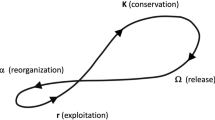Abstract
High population growth and deteriorating economic conditions imperil Africa's natural environment. Conservationists are trying to cope with the threat by working in rural communities. Yet it is unclear whether they can be effective when social and economic change in rural areas is so rapid. Northeast Swaziland provides a case study. The landscape has been transformed since the 1950s, and conservationists are the only people now giving nature conservation a high priority. Land uses incompatible with local nature reserves are supported because they provide jobs. Thus, conservationists find themselves facing a world where wildlife is increasingly devalued as the forces of change accelerate. This paper concludes: (1) conservationists must expand their influence into rural communities, (2) an integrated development and conservation plan is required for northeastern Swaziland, and (3) only the alleviation of poverty will secure the future of nature conservation in Swaziland as well as the rest of Africa.
Similar content being viewed by others
References
Acsadi, G., and Johnson-Acsadi, G. (1990). Demand for children and childspacing. In Acsadi, G., Johnson-Ascadi, G., and Bulatao, R. (eds.),Population Growth and Reproduction in Sub-Saharan Africa: Technical Analyses of Fertility and Its Consequences. The World Bank, Washington, D.C., pp. 155–185.
Areola, O. (1987). The political reality of conservation in Nigeria. In Anderson, D., and Grove, R. (eds.),Conservation in Africa: People, Policies and Practice. Cambridge University Press, Cambridge, pp. 277–292.
Barker, J. (1989).Rural Communities Under Stress: Peasant Farmers and the Slate in Africa. Cambridge University Press, Cambridge.
Bell, M. (1986).Contemporary Africa. Longman, New York.
Booth, A. (1983).Swaziland: Tradition and Change in a Southern African Kingdom. Westview Press, Boulder, Colorado.
Cleaver, K., and Schreiber, G. (1992). Population, agriculture, and the environment in Africa.Finance and Development 29: 34–35.
de Vletter, F. (1983). The Swazi Rural Homestead. Social Science Research Unit, University of Swaziland, Kwaluseni, Swaziland.
Dixon, C. (1990).Rural Development in the Third World. Routledge, New York.
Fair, T., Murdoch, G., and Jones, H. (1969).Development in Swaziland: A Regional Analysis. Witswatersrand University Press, Johannesburg.
Funnell, D. C. (1991).Under the Shadow of Apartheid: Agrarian Transformation in Swaziland. Avebury, Aldershot, England.
GOS. (1987).Fourth national development plan, 1983/84–1987/88.
GOS. (1989).The Fifth National Development Plan. Mbabane, Swaziland.
Grimwood, I. (1973). The Establishment of National Parks. Report to the Government of Swaziland, FAO, Rome.
Hackel, J. D. (1988). Gaining ground?: People, Development, and Nature Conservation in Northern Swaziland. Unpublished Ph.D. dissertation, University of California, Riverside.
Hackel, J. D. (1990). Conservation attitudes in southern Africa: A comparison between Kwazulu and Swaziland.Human Ecology 18: 203–209.
Janzen, D. (1986). The eternal external threat. In Soule, M. E. (ed.),Conservation Biology: The Science of Scarcity and Diversity. Sinauer Associates, Sunderland, Massachusetts, pp. 286–303.
Lewis, D., Kaweche, G. B. and Mwenya, A. (1990). Wildlife conservation outside protected areas—lessons from an experiment in Zambia.Conservation Biology 4: 171–180.
Machlis, G. E., and Tichnell, D. L. (1985).The Stale of the World's Parks. Westview Press, Boulder, CL.
Porter, D., Allen, B., and Thompson, G. (1991).Development in Practice: Paved with Good Intentions. Routledge, New York.
Reilly, T. (1986).The Mlilwane Story: A History of Nature Conservation in Swaziland: Past and Present. Mlilwane Wildlife Sanctuary: The Mlilwane Trust.
Rose, L. (1992).The Politics of Harmony: Land Dispute Strategies in Swaziland. Cambridge University Press, Cambridge.
Ryan, J. (1992). Life Support: Conserving Biological Diversity. Woridwatch paper 108, Worldwatch Institute, Washington, D.C.
Samatar, A. (1992). Social classes and economic restructuring in pastoral Africa: Somali notes.African Studies Review 35: 101–127.
Saunders, D. A., Hobbs, R. J., and Margules, C. R. (1991). Biological consequences of ecosystem fragmentation: a review.Conservation Biology 5: 18–32.
Siddle, D., and Swindell, K. (1990).Change in Tropical Africa: From Colonies to Nation-States. Oxford and Cambridge, MA, Basil Blackwell.
Timberlake, L. (1985).Africa in Crisis: The Causes, the Cures of Environmental Bankruptcy. Earthscan: New York.
Vilakazi, A. (1979). A Study of Population and Development. Ministry of Agriculture and Cooperatives, Mbalane, Swaziland.
West, P., and Brechin, S. (1991).Resident Peoples and National Parks: Social Dilemmas and Strategies in International Conservation. University of Arizona Press, Tucson.
Western, D. (1989). Conservation without parks: Wildlife in the rural landscape. In Western, D., and Pearl, M. C. (eds.),Conservation for the Twenty-First Century. Oxford University Press, Oxford, England, pp. 158–165.
World Bank (1989).Sub-Saharan Africa: From Crisis to Sustainable Growth, The World Bank, Washington, D.C.
World Resources Institute (1992).World Resources, 1992–93. Oxford University Press, Oxford, England.
Wright, P. (1992). Primate ecology, rainforest conservation, and economic development: Building a national park in Madagascar.Evolutionary Anthropology 1: 25–33.
Yeager, R., and Miller, N. (1986).Wildlife, Wild Death: Land Use and Survival in Eastern Africa. State University of New York Press, New York.
Author information
Authors and Affiliations
Rights and permissions
About this article
Cite this article
Hackel, J.D. Rural change and nature conservation in Africa: A case study from Swaziland. Hum Ecol 21, 295–312 (1993). https://doi.org/10.1007/BF00891541
Issue Date:
DOI: https://doi.org/10.1007/BF00891541




